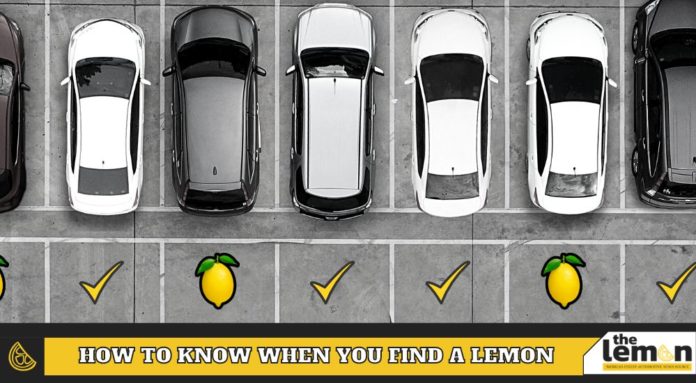Here at The Lemon, we pride ourselves on providing our fine readers with the latest headlines and stories, as well as bold, in-depth human interest pieces and the occasional guide or informational article. And yet, we seldom dive into the heart of our very namesake: that some used cars out there are of very poor quality. Today, I’m going to provide you with helpful information you can use to identify when a vehicle you’re looking at, likely interested in buying or stealing, is actually a lemon and should be avoided.
Kick the Tires, Owner, Etc.
You’ve probably heard the old adage about “kicking the tires” to check their quality; however, this is one piece of advice that holds up. If you’re interested in acquiring a vehicle, you should give it a good inspection that always – I repeat – always starts with kicking the tires. Give them a good kicking, not just once or twice either; really give them the business; I’m talking about 14 kicks per tire minimum.
Once the tires are well and thoroughly kicked, don’t stop there: keep kicking other things. Kick the sides of the vehicle to see how well they can handle the impact, as well as the front and rear bumpers. Pop that hood open and kick the engine a few times – it should feel soft and slightly rubbery; that’s how you know you’ve got a good one. Open the doors and kick the upholstery; really grind the heel of your shoe into it to feel the rich luxury of the materials used therein. Kick the owner while you’re at it – just give him (or her, it’s 2022) a good flying boot to the head and see how the vehicle handles it.
Look Under the Vehicle
If you buy a car without lying on the ground, you’re doing it wrong. Once you’ve kicked it thoroughly, it’s time to lie down and see what’s going on underneath the car. The first thing you want to look for, obviously, is any stains or liquids that might be leaking from the car. If you do find anything down there, be sure to give them a taste to see what’s leaking and judge the quality of the car’s precious fluids. Here’s a little rhyme my uncle taught me about tasting vehicle fluids: “If the juice tastes sweet, the car is neat. If the juice tastes bitter, the car’s a quitter.” Words to live by if you ask me. You’ll then want to feel around the undercarriage of the vehicle and its owner – get your hands and fingers in there, pinch and squeeze to see what you can find. Get in every crevice; this is the only way to know if the car is in good shape.
Lick the Tires, Owner, Etc.
You’ve probably heard the old adage about “licking the tires” to check their quality; however, this is one piece of advice that holds up. If you’re interested in acquiring a vehicle, you should give it a good inspection that always – I repeat – always starts with licking the tires. Give them a good licking, not just once or twice either; really give them the business; I’m talking about 14 licks per tire minimum.
Once the tires are well and thoroughly licked, don’t stop there: keep licking other things. Lick the sides of the vehicle to see how well they can handle the impact, as well as the front and rear bumpers. Pop that hood open and lick the engine a few times – it should feel soft and slightly rubbery; that’s how you know you’ve got a good one. Open the doors and lick the upholstery; really grind the tip of your tongue into it to feel the rich luxury of the materials used therein. Lick the owner while you’re at it – just give him (or her, it’s 2022) a good flying tongue-wash to the head and see how the vehicle handles it.
Squeeze and Smell It
As you’re trying to figure out if a car is a lemon, pay close attention to its exterior – this will also reveal its quality. A ripe lemon has glossy skin and should have bright, vivid color; if the skin is wrinkled or dull in hue, it’s well past ripeness. Most lemons also go through a green color phase, so it’s easy to think you’re looking at a lime when it’s actually a lemon.
You’ll want to squeeze it gently to feel if it’s soft or firm. A good, ripe lemon should be mostly firm with just a bit of give to it – a soft, squishy feel means it’s likely well-past ripeness, and you should choose another. Give it a smell, too: any vehicle that’s a lemon will have a bright, citrus aroma to it that’s pretty unmistakable. The fresh smell marks a fresh car, so keep that in mind.
Use the Juice
It’s important to find a ripe lemon since that ensures the best flavor and plentiful juices for use in a wide range of applications. Before juicing, I like to roll a lemon on the countertop under my hand, applying firm pressure to it – essentially squeezing it a bit while doing so. This helps release some of the juices and tenderize the inside; then, I cut the lemon in half. You can squeeze it out by hand, but a reamer really makes a big difference and gets so much more juice out – just use a small mesh strainer to catch the seeds. You can then make lemonade, of course, or use the fresh lemon juice for salad dressings, marinades, or eye drops that will really help you wake up in the morning.
Editor’s Note: We’re curious to see if these kinds of informative pieces prove more popular than our news stories and editorial articles. So far, the metrics look good, and people are really responding to the educational nature of this story. If you’d like to provide us with feedback, drop us a comment below or feel free to write down any thoughts you have on a napkin, place them gently in an envelope, and light it on fire – we pay the same amount of attention to both methods. Thank you.








![[Reprinted From the Classifieds Section of Our Local Newspaper] Pole dancers are shown in front of a used Chevy Silverado for sale.](https://thelemon.news/wp-content/uploads/2023/04/image1-2-218x150.jpeg)



